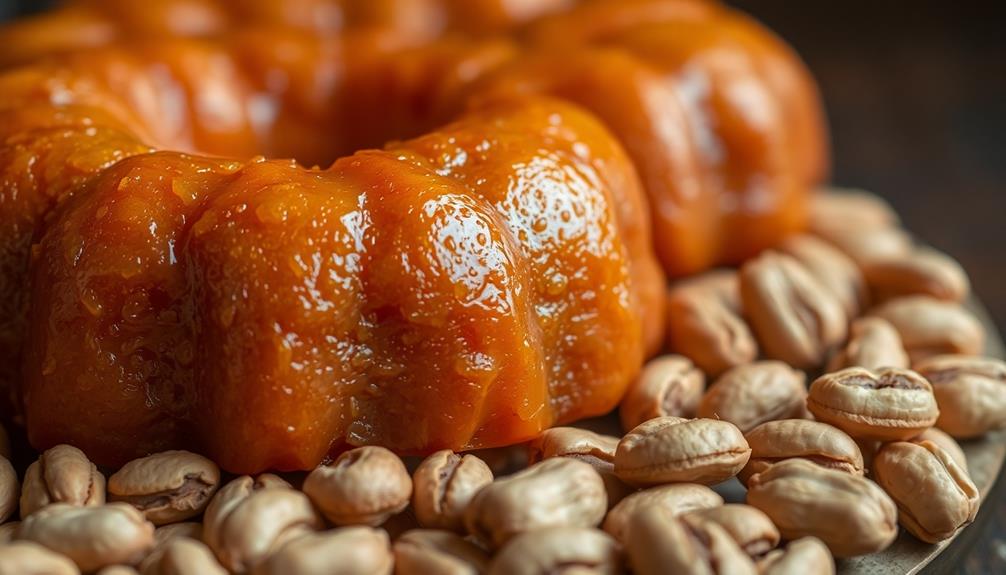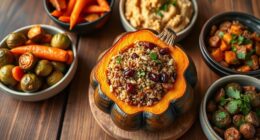Get ready to dive into the delicious world of Pé de Moleque, a classic Brazilian treat that'll have your taste buds dancing with joy! This sweet confection has been around since colonial times, created by enslaved Africans using local ingredients. With a mouthwatering blend of peanuts, sugar, and coconut, Pé de Moleque is a nostalgic reminder of Brazil's rich culinary heritage. Whether you enjoy it as a casual snack or a special treat, the satisfying crunch and caramelized sweetness will make you feel like a kid again. Want to learn how to make this beloved dessert? Keep reading to uncover the secrets!
Key Takeaways
- Pé de Moleque is a classic Brazilian confection made with peanuts, sugar, and coconut, reflecting the country's diverse culinary traditions.
- It symbolizes Brazilian hospitality and community, often served at family gatherings and local festivals celebrating traditional cuisine.
- The preparation involves roasting peanuts and cooking sugar to a specific temperature, resulting in a crunchy or chewy texture.
- Recipe variations exist, including the addition of chocolate or spices, enhancing the overall flavor profile.
- Homemade versions allow for better control over sugar levels and ingredient quality, providing a healthier alternative.
History
The origins of Pé de Moleque can be traced back to the colonial period in Brazil. This delightful confection was likely created by enslaved Africans who blended local ingredients with their traditional recipes. They used simple, readily available materials like sugar, peanuts, and coconut to craft a tasty treat.
Over time, Pé de Moleque evolved as it spread throughout the country. Variations emerged, with some versions featuring cashews or almonds instead of peanuts. Others incorporated cassava flour or included a layer of dulce de leche. No matter the specific ingredients, the core essence remained the same – a chewy, nutty, and utterly scrumptious candy.
Today, Pé de Moleque is a beloved part of Brazilian culture, enjoyed by people of all ages. Its history reflects the diverse culinary traditions that have shaped the nation's gastronomy. Each bite offers a delightful taste of Brazil's rich heritage and the ingenuity of its people.
Recipe
Pé de Moleque, a classic Brazilian confection, is a delightful treat that combines the rich flavors of peanuts and caramelized sugar. This simple yet indulgent dessert has roots in the traditional cuisine of northeastern Brazil, where it has been enjoyed for generations.
The name "Pé de Moleque" translates to "street urchin's foot," a nod to the dish's humble origins as a snack sold by street vendors. Its irresistible blend of crunchy peanuts and chewy caramelized sugar has made it a beloved staple in Brazilian households and a favorite among those with a sweet tooth.
Ingredients:
- 2 cups raw peanuts, shelled and peeled
- 1 cup granulated sugar
- 1/4 cup water
- 1/4 teaspoon salt
Cooking Instructions:
In a heavy-bottomed saucepan, combine the sugar and water. Bring the mixture to a boil over medium-high heat, stirring occasionally, until the sugar has dissolved and the syrup begins to caramelize.
Carefully add the peanuts and salt, and continue to cook, stirring constantly, until the peanuts are evenly coated and the caramel has reached a deep golden-brown color, about 5-7 minutes.
Tips:
Be cautious when working with the hot caramel, as it can cause severe burns. Have all your ingredients and equipment ready before beginning, as the caramelization process moves quickly.
For best results, use freshly shelled and peeled peanuts, as their natural oils will contribute to the overall texture and flavor of the Pé de Moleque. Allow the cooked peanuts to cool completely before enjoying, as the caramel will continue to harden as it cools, creating the perfect chewy and crunchy texture.
Cooking Steps
Grate and mix the key ingredients until they're well-blended.
Knead the mixture thoroughly to get the perfect texture.
Now, divide the mixture into small portions and form them into dough balls, ready to be fried until they're a lovely golden brown!
Step 1. Grate and Mix the Ingredients
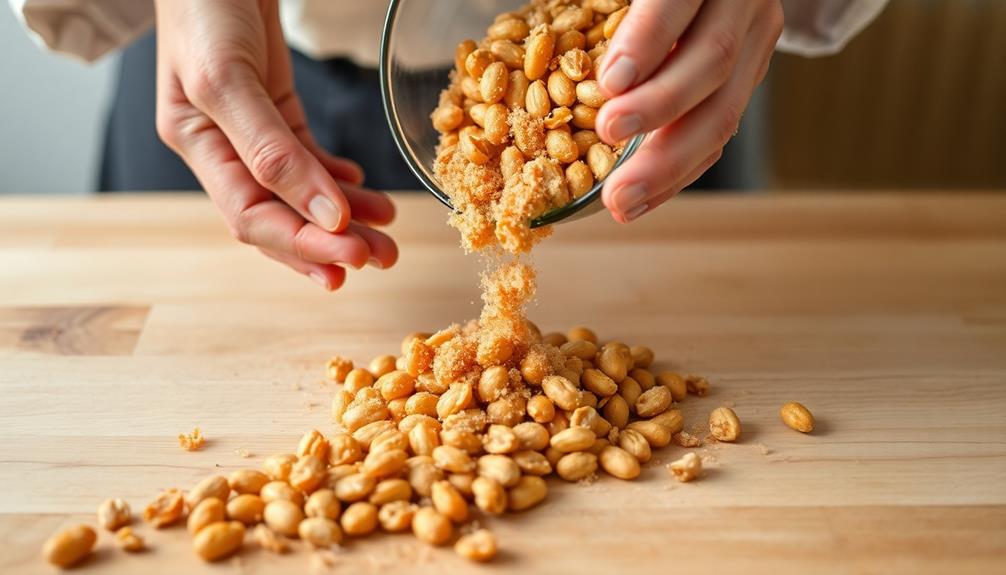
After preparing the ingredients, it's time to grate and mix them together. First, grab your box grater and grate the coconut into long, thin shreds. Make sure to grate over a clean bowl so the coconut doesn't fall onto the counter.
Once you've grated the entire coconut, it's time to add the other ingredients. In goes the brown sugar – just sprinkle it in and use a spoon to mix it all up. The sugar will help bind the coconut shreds together.
Next, pour in the sweetened condensed milk and stir until the mixture is smooth and creamy. Don't be afraid to get in there with your hands to really incorporate everything well.
Now, the fun part – pinching and rolling the mixture into little balls. Scoop up some of the gooey coconut goodness and gently roll it between your palms until you've got a perfect little ball.
Set each one aside on a baking sheet or plate as you go. Once they're all formed, your Pe de Moleque is ready for the next step!
Step 2. Knead the Mixture Thoroughly
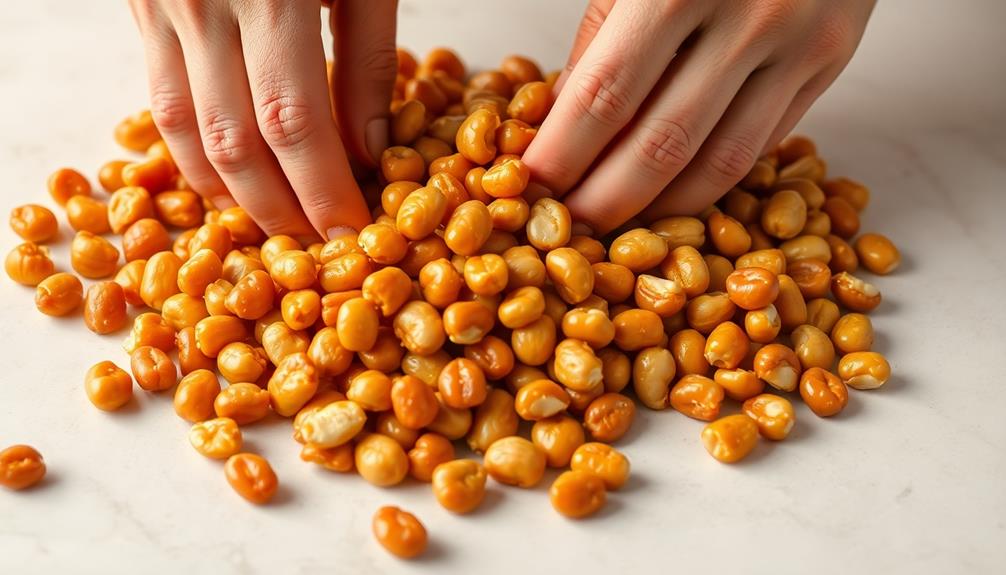
Dive in and thoroughly knead the mixture with your hands. Get in there and get to work! Squish and squeeze the dough, folding it over itself again and again.
You want to really work those ingredients together until the mixture becomes smooth, elastic, and easy to handle. Don't be shy – use those muscles! Knead for about 5 minutes, or until the dough has a nice, even texture.
Next, form the dough into a ball. Place it in a lightly greased bowl, then cover and let it rest for 30 minutes. This gives the gluten a chance to develop, making the dough even more pliable and easy to work with.
After the rest, you're ready to roll out the dough and cut it into shapes. Get creative with different sizes and designs – the possibilities are endless!
Just make sure to keep that dough moving and kneaded well. It'll make all the difference in the final Pê De Moleque treats.
Step 3. Divide Mixture Into Small Portions
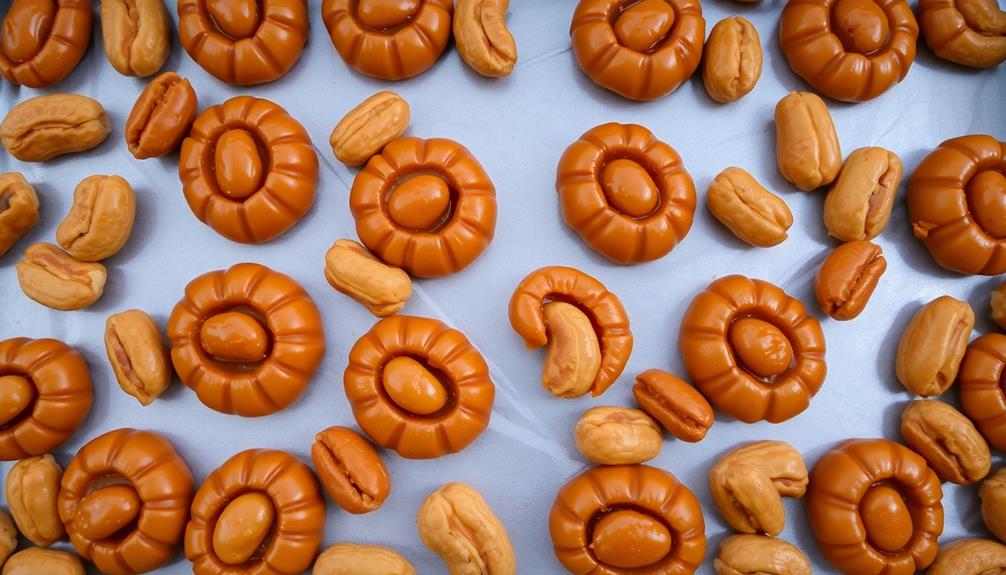
Once the dough has rested, divide it into 12 equal portions. This'll ensure each piece is the perfect size for your tasty treats.
Grab a portion and roll it into a smooth ball between your palms. Repeat this process until you've divided the entire batch. Remember, the more evenly you portion the dough, the better your Pê De Moleque will turn out.
Next, take each ball and gently flatten it with your fingers, shaping it into a round disk about 1/4 inch thick. Be careful not to overwork the dough – you want those layers to stay nice and airy!
Line up the disks on a parchment-lined baking sheet, leaving a bit of space between them. This will give the Pê De Moleque room to puff up as they bake.
With the dough divided and shaped, you're one step closer to sinking your teeth into these irresistible sweets.
Up next, it's time to bake them to golden, caramelized perfection!
Step 4. Form the Dough Balls
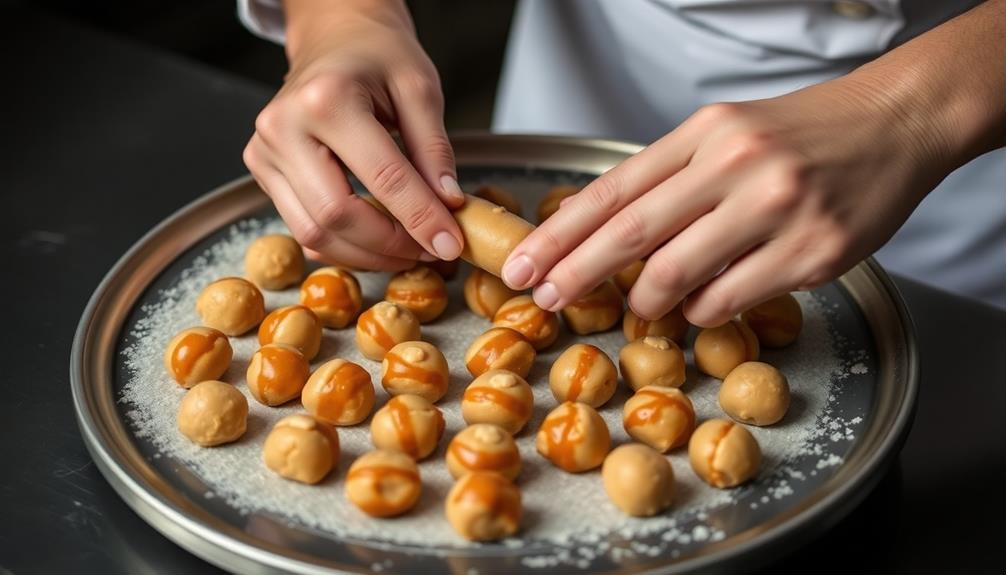
With the dough rested, divide it into 12 equal portions. Take each piece and gently roll it between your palms to form a smooth, round ball.
Try not to overwork the dough – you want to keep it tender and light. Once you've shaped all 12 balls, place them on a parchment-lined baking sheet, spacing them out evenly. This'll give them room to puff up without touching as they bake.
Now, take a fork and gently press down on each dough ball to flatten it slightly, creating that classic "pé de moleque" shape.
Don't press too hard – you don't want to flatten them completely. Just a gentle touch is all it takes. Finally, use a sharp knife to make a small criss-cross pattern on the top of each flattened ball. This'll help them bake up extra crispy and golden brown.
Step 5. Fry the Dough Balls Until Golden

Now that your dough balls are shaped and scored, it's time to fry them up until they're golden brown and crispy.
You'll need to heat up some oil in a pan or pot – just make sure it's hot enough for frying, but not too hot that it's smoking.
Gently drop the dough balls into the oil, being careful not to overcrowd the pan. Let them sizzle and cook for a few minutes, turning them occasionally, until they're a beautiful golden color all over.
Mmm, can you already smell that delicious aroma?
Once they're done, use a slotted spoon to transfer the fried dough balls to a paper towel-lined plate to drain off any excess oil.
Now they're ready to be sprinkled with cinnamon-sugar or served however you like.
Get ready for your taste buds to be delighted – these crispy, golden "Pé De Moleque" doughnuts are about to become your new favorite treat!
Final Thoughts
As we reflect on the journey of the Pé de Moleque, it's clear that this delightful Brazilian dessert has captivated hearts and taste buds alike. From the satisfying crunch of the fried dough to the rich, caramelized sweetness, each bite is a delight. If you’re feeling inspired to create your own Pé de Moleque at home, you can try your hand at making it using a traditional mocotó recipe. This classic recipe calls for simple ingredients like peanuts, sugar, and molasses, which come together to create a treat that is both comforting and delicious. Whether enjoyed during a celebration or as a simple indulgence, Pé de Moleque is a reminder of the joy that can be found in a simple, flavorful dessert.
Whether enjoyed as a casual snack or a special treat, this beloved confection is a true celebration of Brazil's vibrant culinary heritage.
As you savor the final moments of your Pé de Moleque, let the flavors linger and the memories of its preparation bring a smile to your face. This recipe isn't just a dessert – it's a connection to a rich cultural tradition, a moment of indulgence, and a testament to the power of simple, high-quality ingredients.
Frequently Asked Questions
What Is the Origin of the Name "Pé De Moleque"?
You're curious about the origin of the name "pé de moleque," aren't you? It's believed to come from a traditional Brazilian candy made with condensed milk, coconut, and brown sugar – a sweet treat enjoyed by locals for generations.
How Nutritious Is This Traditional Brazilian Dessert?
Well, this traditional Brazilian dessert is quite nutritious. It's made with simple, wholesome ingredients like cassava, coconut, and sugar, providing a good source of carbohydrates, healthy fats, and natural sweetness. Enjoy it as a tasty and satisfying treat!
Can Pé De Moleque Be Made Vegan or Gluten-Free?
You can absolutely make this dessert vegan and gluten-free! Substitute the typical ingredients with plant-based alternatives like coconut milk, rice flour, and natural sweeteners. It's a versatile treat that can accommodate various dietary needs.
How Long Does Pé De Moleque Typically Last Before Spoiling?
How long a perishable food lasts before spoiling depends on various factors, like storage conditions and ingredient composition. Without more details about the specific item, it's difficult to provide an accurate shelf life estimate. Pay close attention to any expiration dates or signs of spoilage.
Are There Any Variations or Regional Differences in Pé De Moleque Recipes?
There can be regional variations in recipes, as different areas may have unique ingredients or preparation methods. Some versions may include additional spices, nuts, or even different types of sugars to achieve distinct flavors.
